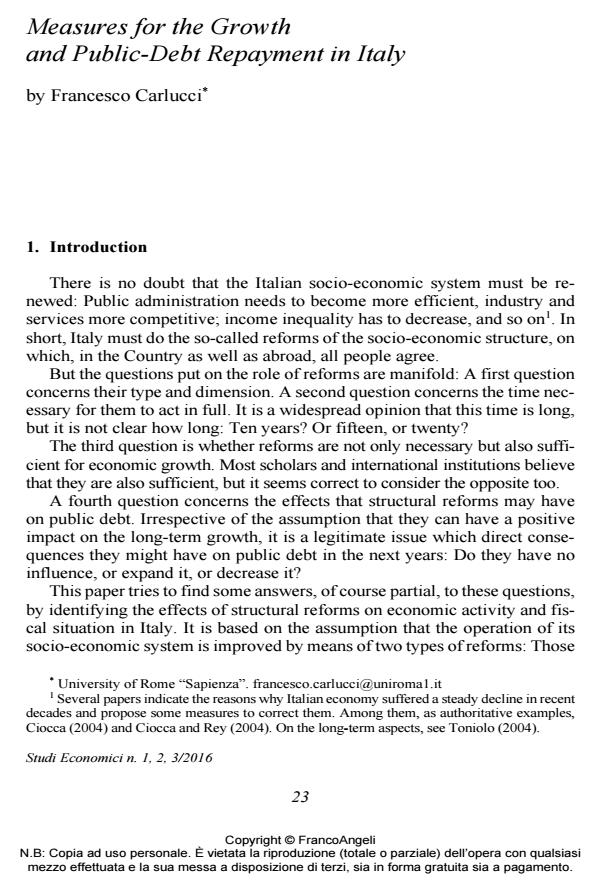Measures for the Growth and Public-Debt Repayment in Italy
Titolo Rivista STUDI ECONOMICI
Autori/Curatori Francesco Carlucci
Anno di pubblicazione 2017 Fascicolo 2016/118-119-120 Lingua Inglese
Numero pagine 36 P. 23-58 Dimensione file 398 KB
DOI 10.3280/STE2016-118003
Il DOI è il codice a barre della proprietà intellettuale: per saperne di più
clicca qui
Qui sotto puoi vedere in anteprima la prima pagina di questo articolo.
Se questo articolo ti interessa, lo puoi acquistare (e scaricare in formato pdf) seguendo le facili indicazioni per acquistare il download credit. Acquista Download Credits per scaricare questo Articolo in formato PDF

FrancoAngeli è membro della Publishers International Linking Association, Inc (PILA)associazione indipendente e non profit per facilitare (attraverso i servizi tecnologici implementati da CrossRef.org) l’accesso degli studiosi ai contenuti digitali nelle pubblicazioni professionali e scientifiche
Some of the more relevant interventions that are proposed in Italy to foster economic growth and markedly reduce its public debt are here analysed. Conditional on general and specific measures (structural reforms, public investments not ncluded in the ratio debt/GDP, additional investments, reduction of the tax wedge, depreciation of the euro against US dollar), simulations of economic growth rates and usual fiscal parameters are made. The only intervention that in the long run seems to foster country’s economy and at the same time drastically reduce its public debt is the devaluation of euro. It must be accompanied by the continuous pursuit of reforms that operate in a general form on the whole system.
Keywords:Structural reforms, economic growth, Italy, public debt, econometric model, simulation.
Jel codes:C54, E17, E52, H68
- Cicinelli C., Cossio A., Nucci F., Ricchi O. and Tegami C. (2010), “The Italian Treasury Econometric Model (ITEM)”, Economic Modeling, 27, 1, 125-133.
- Ciocca P. (2004), “L’economia italiana: un problema di crescita”, Rivista italiana degli economisti, suppl. to n. 1, 7-28.
- Ciocca P., Rey G.M. (2004), “Per la crescita dell’economia italiana”, Economia italiana, 2, 333-354.
- Engle R.F., Granger C.W.J. (1987), “Cointegration and Error Correction: Representation, Estimation, and Testing”, Econometrica, 55, 251-76.
- Engle R.F., Yoo B.S. (1987), “Forecasting and Testing in Co-integrated Systems”, Journal of Econometrics, 35, 143-159.
- Fuller W.A. (1976), Introduction to Statistical Time Series. New York: Wiley.
- Gerali A., Notarpietro A., Pisani M. (2014), “Macroeconomic effects of simultaneous implementation of reforms after the crisis”, Temi di discussione. Working Paper n. 997. Banca d’Italia, Rome.
- Gregory A., Hansen B. (2006), “Residual-based Tests for Cointegration in Models with Regime Shifts”, Journal of Econometrics, 70, 99-126.
- Juselius K., Franchi M. (2007), “Taking a DSGE Model to the Data Meaningfully”, Economics: The Open-Access, Open-Assessment E-Journal, 1, 1-38.
- Lusinyan L., Muir D. (2013), “Assessing the Macroeconomic Impact of Structural Reforms: The Case of Italy”, Working Paper No. 13/22. IMF, Washington.
- Ministry of Economics and Finance (2013), Document of Economics and Finance 2013, Rome.
- Ministry of Economics and Finance (2014), Document of Economics and Finance 2014, Rome.
- Ministry of Economics and Finance (2015), Document of Economics and Finance 2015, Rome.
- OECD (2014a), Economic Outlook. May. OECD Publishing, Paris.
- OECD (2014b), Taxing wages 2014, April. OECD Publishing, Paris.
- OECD (2015), Economic Outlook: Statistics and Projections. OECD Publishing, Paris.
- OECD (2016), Economic Outlook: Statistics and Projections. OECD Publishing, Paris.
- Pesaran M.H., Smith R. (2011), “Beyond the DSGE straitjacket-super-1”, Manchester School, 79, s2, 5-16.
- Toniolo G. (2004), “L’Italia verso il declino economico? Ipotesi e congetture in una prospettiva secolare”, Rivista italiana degli economisti, suppl. to n. 1, 29-45.
- Carlucci F. (2008), L’Italia in ristagno, Milan: FrancoAngeli.
- Bagnai A., Carlucci F. (2003), “An Aggregated Model for the European Union”, Economic Modeling, 20, 623-649.
- Annicchiarico B., Di Dio F., Felici F., Nucci F. (2014), “Assessing Policy Reforms for Italy Using ITEM and QUEST III”, Rivista di Politica Economica, 3, 211-244.
- Annicchiarico B., Di Dio F., Felici F. (2013), “Structural Reforms and the Potential Effects on the Italian Economy”, Journal of Policy Modeling, 35, 1, 88-109.
Francesco Carlucci, Measures for the Growth and Public-Debt Repayment in Italy in "STUDI ECONOMICI " 118-119-120/2016, pp 23-58, DOI: 10.3280/STE2016-118003